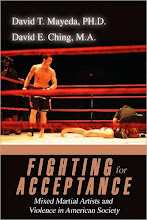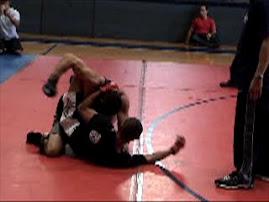 In late June of this year, mixed martial arts (MMA) experienced its second death due to competition from a regulated event. Tragedies in sport and society are distressing enough for those directly involved. Added media attention does not always help, and in some cases can contribute to families’ and friends’ grief for their deceased loved ones. For this reason, I will not go into detail about the particular event noted (responsible writing on this and a previous death linked to sanctioned MMA can be found here, here, and here). Rather, this tragedy reminded me of the intrinsic competitive nature of sport, MMA’s evolving structure, and how society regulates violence in sport.
In late June of this year, mixed martial arts (MMA) experienced its second death due to competition from a regulated event. Tragedies in sport and society are distressing enough for those directly involved. Added media attention does not always help, and in some cases can contribute to families’ and friends’ grief for their deceased loved ones. For this reason, I will not go into detail about the particular event noted (responsible writing on this and a previous death linked to sanctioned MMA can be found here, here, and here). Rather, this tragedy reminded me of the intrinsic competitive nature of sport, MMA’s evolving structure, and how society regulates violence in sport.First, however, it is important that violence is properly understood and defined. Depending on an individual’s personal background, his or her threshold for violence can vary immensely, to the degree that an event may be considered violent for one individual and not another. A few years ago, for example, dog fighting received extensive media attention as a highly violent, brutal, and cruel practice following the Michael Vick controversy. In Afghanistan, however, dog fighting as a social institution has risen in popularity since the Taliban’s ousting in 2001. While not all in Afghanistan support the practice, it should not be surprising that violence like this is celebrated among a significant proportion of males, given the country’s war-torn history and lack of entertainment outlets. In short, context is critical to one’s threshold for violence.
The World Health Organization defines violence as such:
The intentional use of physical force or power, threatened or actual, against oneself, another person, or against a group or community, that either results in or has a high likelihood of resulting in injury, death, psychological harm, maldevelopment or deprivation. (p. 6).
If applying this definition to sport, and to MMA specifically, MMA is at its core, violent. Injuries, even death, are a risk in all sports. Even in non-contact sports, such as long distance running, deaths occur on occasion (though the absolute number of long distance runners is massive in comparison to MMA). However, in most sports, there is not intent to harm. In combat sports, "the intentional use of physical force…against…another person" is required and formally sanctioned.
Furthermore, MMA competitions have a high likelihood of injury. Research published in peer-review academic journals has noted that MMA competitions yield injuries similar in prevalence to other combat sports, typically facial lacerations, contusions, and joint injuries. This of course, does not automatically mean MMA is the most violent or dangerous sporting practice, but to deny its potential for brutality would be remiss.
The danger in MMA’s structure lies in its under-funded feeding grounds. Within the United States, prominent MMA organizations such as the Ultimate Fighting Championship (UFC) and Strikeforce have the resources and existing infrastructure to prevent, or at least minimize, the most serious, tragic levels of violence. Earlier this year UFC welterweight contender, Thiago Alves, was forced to withdraw from competition because of a discovered brain irregularity. These and other medical procedures (e.g., thorough blood work) cost money that smaller, regional organizations and local fighters may not be able to afford on a consistent basis.
The conundrum for the UFC and other established MMA organizations is that they need these smaller "minor league" organizations to nurture future competitors who can one day reach the highest level of competition (currently the UFC). Yet, the major and minor MMA organizations lack a formal relationship. None of the major MMA organizations provide smaller, regional ones with the financial backing that would allow for a more robust medical infrastructure and help prevent the most serious ramifications of sporting violence. Thus, up and coming fighters must gain experience in smaller organizations, where the risky consequences of more serious violence and injury rise.
In other sports, even violent, collision-sports, such as football, an infrastructure exists that at least in theory is there to help prevent tragedy at all levels, from the NFL, down through the collegiate, high school, and even Pop Warner levels (true, serious injuries, even deaths, still occur on occasion). Granted, MMA has only been formally institutionalized in the United States now for 17 years. Still, we as a society know the immediate and long-term risks of collision and combat sports (football induced head trauma is now well documented).
Professional and semi-pro mixed martial artists – frequently seduced by the financial gains and popularity that the sport’s biggest stars enjoy – should be treated as human beings, not as collateral damage dismissed in the wake of the sport’s growth. Neither society’s thirst for violence nor a sport’s increasing popularity should be cited to justify or excuse athlete safety.
Perhaps this means larger MMA organizations like the UFC and Strikeforce need to consider investing their profits in smaller organizations to help improve an infrastructure that bolsters safety precautions – obviously a major financial undertaking and one unlikely to transpire. However, this would be an investment in the fighters, who at the lower levels receive less reward for more risk. Bottom line – until some structural change is made, sporting violence will continue to harm MMA athletes at the lower levels to a disproportionately large degree.

Blogcatalog








damn ive never been so confused in my life
ReplyDeleteInteresting stuff, but my impression was that the majority of americans doesnt want free healthcare. So (except for footballers?) everybody in your country, who is not a pro, has to pay for their own medical checkups and potential treatment in case of injury. And everybody with a bit of sense knows that sports lead to injury (doubt anybody have ever done sports on a regular basis without injury). I dont want to get into the whole "free healthcare -> longer lifespan, less crime -> more money made overall in the country and etc."-stuff.
ReplyDeleteBut if you guys think that people should pay for healthcare themselves, why should semipro athletes, who know (again unless they are clueless) that their sport has a extra high risk of injury, not pay. Why are they more worth than the guy dying of obesity, because he knew he wouldnt be able to pay the bills from sports injuries?
Im a supporter of free healthcare, but when you choose not to. Then why should the line be drawn, at people who decide to do something dangerous?
Mixed Martial Arts and other contact sports such as football and boxing, it is inevitable for them to not getting injured, but with each sports' governing body support, it can decrease the chances of having life-threatening injuries from even surfacing on their athletes. When my friend is still a budding MMA athlete, he always underwent a rigorous training to get him in good condition for his battles, but after watching his final fight, I can easily see that he wasn't cut out to tread that path at all. Weeks after finally quitting the sport, I brought him to the cosmetic dentist (Ft. Lauderdale clinic) to bring back the teeth he lost on his previous battles, as a mark of his departure.
ReplyDeleteAfter a visit to the dental (Fort Lauderdale) clinic, he decided to talk to his family and friends about his new path in life and how can they support him on that, which was a very nice thing to see.